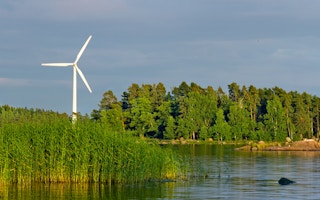With the effects of global climate change being felt across the planet – in the form of water shortages, crop failures, and devastating natural disasters costing billions in economic damages – the global business community is beginning to realise the need to quickly reduce carbon emissions.
To continue reading, subscribe to Eco‑Business.
There's something for everyone. We offer a range of subscription plans.
- Access our stories and receive our Insights Weekly newsletter with the free EB Member plan.
- Unlock unlimited access to our content and archive with EB Circle.
- Publish your content with EB Premium.
And one of the most effective ways to achieve that is to put a price on carbon, said sustainability professionals at the recent Responsible Business Forum on Sustainable Development. Through a transparent pricing mechanism, the business community can contribute to the global goal of capping temperate rise at 2 degrees.
“The only way that we’ll be able to get there is for carbon to be priced in some form,” said Mathew Nelson, Asia Pacific managing partner, climate change and sustainability services at global consultancy firm EY.
Jurisdictions such as South Korea, New Zealand, the European Union, Japan and Australia already have some form of national carbon pricing mechanism. The world’s biggest polluter China will be starting its own carbon trading scheme next year.
With the United Nations climate change talks in Paris just days away, businesses have been calling for a global carbon price to help drive investments into clean technologies.
However, such a global deal seems unlikely as governments will disagree about the form the pricing should take and how the mechanism should work, said sustainability experts.
“We won’t get an agreement from Paris. Some will want direct regulation, some will want taxes, some will want an emissions trading scheme. And each country will go down its own path,” said Nelson.
His view echoed that of Christiana Figueres, the United Nations’ climate chief, who said last month (Oct 27) that a climate deal to be agreed in Paris in December will not include a global carbon price.
Corporate effort on the rise
In the absence of a global carbon price, individual companies have already started incorporating a carbon price when they decide whether to invest in new projects. Carbon pricing schemes include a tax on the amount of carbon dioxide emitted, a cap-and-trade which allows companies to auction off their unused carbon credits, and a hybrid of the two.
According to CDP, an environmental data group, the number of companies putting a price on their carbon pollution has risen sharply in the past 12 months.
United States carmaker General Motors, Swiss mining company Glencore, and Hong-based airline Cathay Pacific are among 437 companies that currently report the use of carbon pricing measures, triple the number from last year, CDP said in a report in September.
Dutch life sciences company DSM is one such company, and it prices its emissions at 50 euros per tonne, Roelof Westerbeek, executive vice president, told the audience of about 150 people. In comparison, the current EU benchmark carbon prices are about eight euros per tonne. Launched in 2005, the EU scheme was the first large trading system and remains the biggest.
Carbon once traded at a high of 32 euros per tonne on the system but sank to a record low of below 3 euros in 2013, after the Kyoto Protocol expired in 2012 and no global system replaced it.
The high price the company puts on carbon translates to higher costs for the company but it also helps ensure that all potential investments are financially sound.
“It’s a start,” Westerbeek said. “We believe that it’s one way of mitigating climate risk and a way of motivating ourselves to invest in new, cleaner technologies.”
Dave Carlson, senior business development director, power and gas of Singapore market regulator SGX, said that a carbon tax is one of the best ways to get companies to turn away from fossil fuels and cut emissions.
“It’s a fairly blunt instrument but it works,” Carlson. “Taxes have been proven to change behaviour very quickly.”
From national efforts to global efforts
At the end of the day, whether countries or governments decide to implement carbon pricing schemes, the purpose of such schemes must be to help the world make the transition to a low-carbon economy, said Renat Heuberger, chief executive officer of South Pole Group, a Swiss firm which advises companies on greenhouse gas reductions.
Making that transition will bring global environmental benefits and new business opportunities, he said.
“That should be the ultimate aim,” he said. “From a business perspective, I don’t understand why people still fail to see the massive opportunity that low-carbon growth brings.”
EY’s Nelson added that current moves by companies and governments to introduce a price on carbon is encouraging, despite the fact that a global agreement is unlikely at Paris.
Individual national plans to reduce emissions will spur governments to adopt policies that will reduce the carbon they produce, and it is likely that these policies will include a price on carbon that suits local businesses and economic conditions, Nelson said.
Over time, different corporate, regional and even national schemes would eventually converge into a single market.
“From Paris, it will be a case of each country figuring out which policies they are going to implement to fulfil their targets,” he said. “And from that point onwards, we may eventually get some agreement on how to get cross-border pricing.”
This article was first published on Future Ready Singapore.










